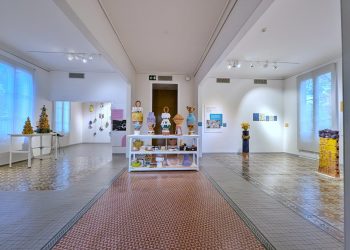Ewen Henderson had an international reputation as a sculptor who took clay into a new expressiveness. He is represented in the Victoria & Albert Museum, but much of his work has gone abroad to the Museum of Modern Art in Tokyo, the Metropolitan Museum of Art in New York and the Australian National Gallery, Canberra.
For Henderson, “fluxed earth”, as he called clay, was capable of being stretched and teased into complex new forms. His construction methods produced objects with a multiplicity of colour and textures, edges and interior spaces. His mastery of form was based on his insights as a painter, and he always stressed drawing as the key to his three-dimensional achievements. His intense, visceral vision was born out of his love of the natural world; he believed in making art that asked new questions. Henderson had a restless, outspoken personality.
He came late to art. He was born in Staffordshire, to a Scottish medical family (his father was a GP in a grim mental hospital). Ewen and his brother boarded at a grammar school, and he did his National Service in the RAF, in north Germany. After, he went to work for a Yorkshire chemical company before moving to Cardiff to run a branch specialising in timber preservation, and later said of this time: “I was guilty of making unrottable revolting houses in Newport which should have been allowed to rot very quickly.”
Although Henderson made work on the wheel, he quickly felt limited by it and constructed his pots freely, since he felt there was an inherent dynamic in hand-building, which had more expressive potential, reflecting his romantic absorption of natural things and their extraordinary asymmetry. Henderson found such qualities in the art he admired, from the early Mediterranean, the Far East and pre-Colombian America. He was also drawn to 20th-century culture, to painters such as Braque, Lanyon and Diebenkorn. His wide interests in music and literature enriched his intellect and anarchic wit.
Over 30 years, alongside a distinguished teaching career at Camberwell, Henderson developed a complex landscape of forms, some of which populated the sculpture garden he and his wife, Kay, created in Camden Town. He worked on a variety of vessels, building them up in layers, using clay bodies into which bone china or porcelain might be laminated. The addition of stains and oxides – on tall pots as well as small tea bowls – created rich colour; when used to excess, these pigments became rough and blistered. The result was almost volcanic, redolent of the firing process and Earth’s own geology. By building in texture and palette simultaneously, body and colour became one. Only American ceramic sculptor Peter Voulkos worked with energy as highly charged as Henderson’s.
By the late 80s, Henderson’s concerns were more sculptural, and he largely abandoned the vessel in favour of intricate open structures – often monumental – investigating his interest in intersecting volumes, spaces, edges and contours: a three-dimensional development of Cubism. These projects were paralleled by radical abstract gouaches and watercolours. His interest in early contributions to the landscape resulted in a series of monoliths based on British megalithic sites. Sculptures from this made an ambitious installation at the Economist Plaza in London in 1994 and the genesis of a touring exhibition in 1995. That year he also curated Pandora’s Box at the Crafts Council, an anthology of ceramics and painting which shaped his aesthetic. He died in 2000 aged 66.
Text by David Whiting
Artist profile created with the participation of Marsden Woo, London. Visit Ewen Henderson’s page on Marsden Woo’s website.
Featured work
Late Abstractions, 1998-1999


Many of the best potters were initially painters. When Ewen Henderson (1934-2000) went to study ceramics at Camberwell in the late 1960s, he brought a painter’s freedom to clay, using it as an open canvas for his ideas. His early pots showed his abilities with colour as well as hand-built form, the surfaces increasingly painterly as he developed stains and oxides which coloured and often blistered surfaces. The pieces eventually opened out into more intricate structures as he improvised with planes, edges and junctures, a spatial exploration at once delicate and powerful. There was a watercolourist’s sensitivity to texture and hue, his constructions reflective of various landscapes, of a wide range of found objects and shapes that were fertile with suggestion.
The work, constantly evolving, was as restless and energised as its maker, an art that posed questions rather than easy answers. As he remarked; “Every beginning has an infinite number of endings, and more excitingly, every ending has a number of new beginnings”, the best description of his physical approach. Henderson was essentially a collagist, a playful experimenter with clay, in his later years developing these ideas on paper too, drawn to the inherent layers, overlaps and spatial intrigues of complex forms.
David Whiting















